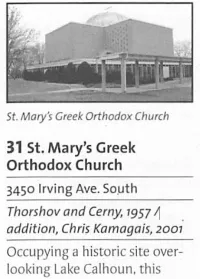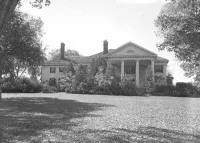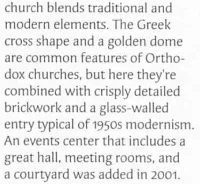Share what you know,
and discover more.
Share what you know,
and discover more.
Jan 01, 2009

-

- Charmaine Bantugan
3450 Irving Ave S, Minneapolis, MN, USA
3450 Irving Ave S Home History Thorshov and Cerny. 1957 /addition, Chris Kamagais, 2001 Occupying a historic site over looking Lake Calhoun, this church blends traditional and modern elements. The Greek cross shape and a golden dome are common features of Ortho- dox churches, but here they're combined with crisply detailed brickwork and a glass-walled entry typical of 1950s modernism. An events center that includes a great hall, meeting rooms, and a courtyard was added in 2001. LOST 5 St. Mary's stands on a site with a long history of buildings. In the courtyard, a bronze plaque set in a boulder commemorates the Pond cabin, built by brothers Samuel and Gideon in 1834. The next occupant of note in the area was William King, whose 1,400-acre Lyndale Farm included this site. In 1879, coinciding with completion of the Motor Line from downtown, King built his Lake Calhoun Pavilion at this location. The multi- story, all-wood structure offered verandas facing the lake. By the early 1880s, after various real estate perturbations, developer Louis Menage took over the pavilion and renamed it the Lyndale Hotel. In an era of cigar smoking, oil lamps, and open flames, wooden hotels were notoriously prone to combustion, and the Lyndale burned down in 1888. The site then remained vacant until 1901, when the Frank B. Forman House appeared. For- man, who founded a paint and glass company, built the 20-room mansion for himself and his wife. The Classical Revival-style home featured a two-story-high entrance porch and views of the lake. For- man died in 1912, but his wife, an eccentric woman known for her kindness to neighborhood children, lived in the house until her death in 1949. The house was demolished six years later. An insurance company made plans for an office structure on the site, but neighbors were opposed, and in the end St. Mary's acquired the property for its church. Citation: Millett, Larry. AIA Guide to the Minneapolis Lake District. Minnesota Historical Society Press, 2009.
3450 Irving Ave S, Minneapolis, MN, USA
3450 Irving Ave S Home History Thorshov and Cerny. 1957 /addition, Chris Kamagais, 2001 Occupying a historic site over looking Lake Calhoun, this church blends traditional and modern elements. The Greek cross shape and a golden dome are common features of Ortho- dox churches, but here they're combined with crisply detailed brickwork and a glass-walled entry typical of 1950s modernism. An events center that includes a great hall, meeting rooms, and a courtyard was added in 2001. LOST 5 St. Mary's stands on a site with a long history of buildings. In the courtyard, a bronze plaque set in a boulder commemorates the Pond cabin, built by brothers Samuel and Gideon in 1834. The next occupant of note in the area was William King, whose 1,400-acre Lyndale Farm included this site. In 1879, coinciding with completion of the Motor Line from downtown, King built his Lake Calhoun Pavilion at this location. The multi- story, all-wood structure offered verandas facing the lake. By the early 1880s, after various real estate perturbations, developer Louis Menage took over the pavilion and renamed it the Lyndale Hotel. In an era of cigar smoking, oil lamps, and open flames, wooden hotels were notoriously prone to combustion, and the Lyndale burned down in 1888. The site then remained vacant until 1901, when the Frank B. Forman House appeared. For- man, who founded a paint and glass company, built the 20-room mansion for himself and his wife. The Classical Revival-style home featured a two-story-high entrance porch and views of the lake. For- man died in 1912, but his wife, an eccentric woman known for her kindness to neighborhood children, lived in the house until her death in 1949. The house was demolished six years later. An insurance company made plans for an office structure on the site, but neighbors were opposed, and in the end St. Mary's acquired the property for its church. Citation: Millett, Larry. AIA Guide to the Minneapolis Lake District. Minnesota Historical Society Press, 2009.
Jan 01, 2009
3450 Irving Ave S, Minneapolis, MN, USA
3450 Irving Ave S Home HistoryThorshov and Cerny. 1957 /addition, Chris Kamagais, 2001
Occupying a historic site over looking Lake Calhoun, this church blends traditional and modern elements. The Greek cross shape and a golden dome are common features of Ortho- dox churches, but here they're combined with crisply detailed brickwork and a glass-walled entry typical of 1950s modernism. An events center that includes a great hall, meeting rooms, and a courtyard was added in 2001.
LOST 5 St. Mary's stands on a site with a long history of buildings. In the courtyard, a bronze plaque set in a boulder commemorates the Pond cabin, built by brothers Samuel and Gideon in 1834. The next occupant of note in the area was William King, whose 1,400-acre Lyndale Farm included this site. In 1879, coinciding with completion of the Motor Line from downtown, King built his Lake Calhoun Pavilion at this location. The multi- story, all-wood structure offered verandas facing the lake. By the early 1880s, after various real estate perturbations, developer Louis Menage took over the pavilion and renamed it the Lyndale Hotel. In an era of cigar smoking, oil lamps, and open flames, wooden hotels were notoriously prone to combustion, and the Lyndale burned down in 1888. The site then remained vacant until 1901, when the Frank B. Forman House appeared. For- man, who founded a paint and glass company, built the 20-room mansion for himself and his wife. The Classical Revival-style home featured a two-story-high entrance porch and views of the lake. For- man died in 1912, but his wife, an eccentric woman known for her kindness to neighborhood children, lived in the house until her death in 1949. The house was demolished six years later. An insurance company made plans for an office structure on the site, but neighbors were opposed, and in the end St. Mary's
acquired the property for its church.
Citation: Millett, Larry. AIA Guide to the Minneapolis Lake District. Minnesota Historical Society Press, 2009.
Posted Date
Sep 28, 2023
Historical Record Date
Jan 01, 2009
Source Name
AIA Guide to the Minneapolis Lake District
Delete Story
Are you sure you want to delete this story?
Sep 23, 1955
Sep 23, 1955

3450 Irving Avenue South, Minneapolis, MN, USA
Frank B. Forman residence, 3450 Irving Avenue South, Minneapolis Photographer: Minneapolis Star Journal Tribune Content: 09/23/1955
3450 Irving Avenue South, Minneapolis, MN, USA
Frank B. Forman residence, 3450 Irving Avenue South, MinneapolisPhotographer: Minneapolis Star Journal Tribune
Content: 09/23/1955
Posted Date
Apr 27, 2022
Historical Record Date
Sep 23, 1955
Source Name
Minnesota Historical Society
Source Website
Delete Story
Are you sure you want to delete this story?












